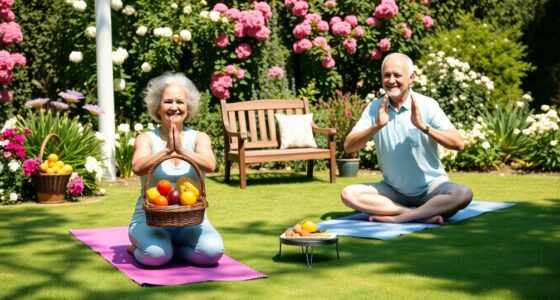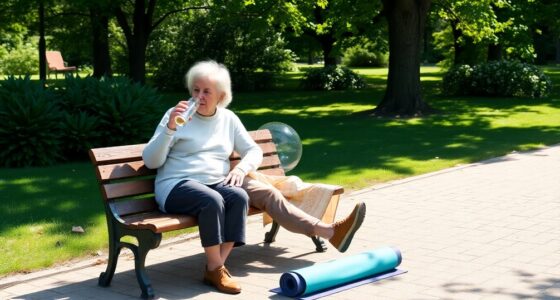To stay healthy as you age, it’s important to have regular health assessments that include screenings for chronic conditions, functional ability, and life expectancy. Vaccinations like flu, pneumonia, and shingles are essential to prevent illness, while cancer screenings help catch issues early. Maintaining a healthy lifestyle with good nutrition and physical activity boosts your well-being. Don’t forget the value of behavioral counseling and personalized preventive care, which can make a real difference—continue exploring these strategies to learn more.
Key Takeaways
- Conduct regular health assessments to detect issues early and personalize preventive care based on functional status and comorbidities.
- Ensure elderly receive recommended vaccinations, including influenza, pneumococcal, shingles, and tetanus/diphtheria.
- Follow age-specific cancer and disease screening guidelines, adjusting for individual health and life expectancy.
- Promote healthy lifestyle modifications like balanced nutrition, regular physical activity, and mental well-being practices.
- Evaluate functional ability and prognosis to tailor preventive strategies, minimizing unnecessary interventions and focusing on quality of life.
The Importance of Regular Health Assessments

Regular health assessments are essential for seniors because they help detect health issues early, leading to better outcomes. As an older adult, participating in regular health assessments, like annual wellness exams, allows you to stay on top of your health. These exams include measurements of height, weight, BMI, and discussions about medications, diet, and activity levels. Regular check-ups provide a thorough overview of your overall health, guiding personalized prevention and treatment plans. Early detection of potential problems through routine assessments reduces the risk of complications and hospitalizations. For example, monitoring chronic conditions is crucial, as chronic disease management can significantly improve quality of life. For older adults, these evaluations are especially important for monitoring chronic conditions and updating preventive care strategies. Staying consistent with wellness exams ensures you maintain better health and quality of life as you age. Incorporating data-driven strategies into your health management can further optimize your outcomes. Additionally, leveraging preventive health screenings can identify risks before symptoms develop, further supporting your health maintenance efforts.
Essential Vaccinations for Older Adults
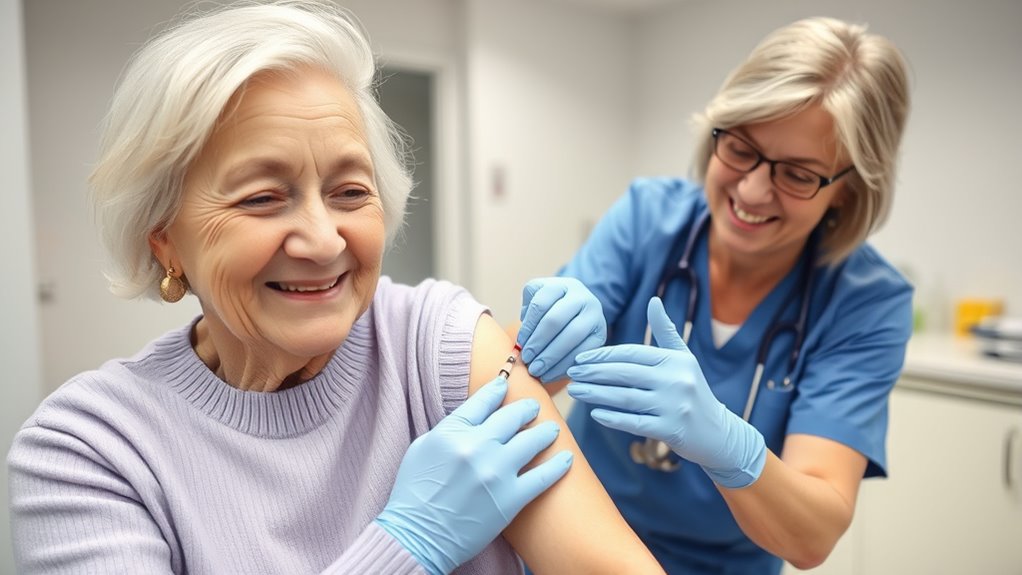
Staying up-to-date with essential vaccinations is a crucial part of maintaining your health as you age. Vaccines help boost your immunity and protect you from serious diseases.
Older adults should get the annual influenza vaccine, with high-dose options offering better protection. Pneumococcal vaccines, like PCV15 and PCV20, are recommended to prevent pneumonia, meningitis, and bloodstream infections. Lesser-known camping spots often feature unique health benefits, such as access to fresh air and outdoor activity that can complement vaccination efforts.
If you’re over 50, getting a shingles vaccine reduces your risk of shingles and postherpetic neuralgia. Additionally, updating your tetanus and diphtheria vaccines every 10 years guarantees continued immunity.
These vaccines collectively lower your chances of contracting preventable infectious diseases, helping you stay healthier and more active as you age. Staying current with your vaccinations is a simple yet vital step in your overall health plan. Incorporating preventive health measures such as vaccination into your routine can further enhance your resilience against illnesses. Regularly reviewing your immunization status with healthcare providers is an important aspect of comprehensive health management.
Cancer Screening Guidelines for Seniors

Are you aware of the recommended cancer screenings for seniors? Staying current with screening guidelines is key to preventive care. For women aged 50-74, mammograms every two years are advised, possibly continuing up to age 79 based on health. Adults aged 50 to 75 should follow colorectal cancer screening through stool tests, sigmoidoscopy, or colonoscopy, with frequency depending on the method. Routine Pap smears aren’t recommended for women over 65 if they’ve had adequate prior screening. Additionally, screening for abdominal aortic aneurysm is advised once for men aged 65-75 who smoked. Remember, age-specific recommendations depend on individual health, and benefits may diminish with limited life expectancy. Evidence-based guidelines from reputable organizations support these practices to ensure optimal preventive care. Incorporating screening recommendations can further assist seniors in maintaining their health and adhering to screening schedules. Regular health screenings play a crucial role in early detection and overall well-being for seniors.
Managing Chronic Conditions Through Screenings

Managing chronic conditions in seniors depends heavily on proactive screenings that enable early detection and effective treatment. Regular screenings for older adults help catch issues like high blood pressure, high cholesterol, and diabetes before they worsen. Utilizing HEPA filtration and other air quality technologies can also improve indoor environments, potentially reducing respiratory complications linked to chronic illnesses. Incorporating nutritional awareness can further support management strategies by promoting healthier lifestyles. Additionally, understanding air quality and its impact on respiratory health can help mitigate some of the risks associated with chronic conditions. Recognizing the importance of mammography guidelines may also be relevant for detecting breast cancer early in older women, ensuring timely intervention. As technology advances, automation in healthcare can facilitate more consistent and personalized screening programs for the elderly, improving overall health outcomes.
Lifestyle Changes to Support Healthy Aging

Making healthy lifestyle changes can markedly improve your aging process. Choosing nutritious foods and staying active helps maintain strength, mobility, and mental clarity. Engaging in music therapy can also support emotional well-being and social interaction as you age. Incorporating mindfulness practices may further enhance emotional resilience and overall quality of life during the aging process. Additionally, maintaining adequate hydration and nutritional support such as vitamins and minerals can bolster health and vitality in later years. For example, selecting appropriate greenhouse-grown vegetables can ensure access to fresh, nutrient-rich produce year-round, supporting overall health. Upgrading your Kia Tuning can also serve as a metaphor for making tailored adjustments to improve your well-being.
Nutritious Diet Choices
Adopting a nutritious diet is essential for supporting healthy aging and reducing the risk of chronic diseases. When you focus on good nutrition, you can make smarter choices for your health.
For example:
- Fill your plate with fruits, vegetables, whole grains, and lean proteins to promote a healthy diet that fights chronic diseases like heart disease and diabetes.
- Incorporate healthy fats from nuts, avocados, and olive oil, which can lower your mortality risk by 50%. Understanding the cost of electric bikes can help in making environmentally friendly transportation choices that also promote physical activity. Additionally, considering beach destinations can encourage outdoor activities that support overall well-being.
- Limit trans fats and processed foods to prevent up to 19% of coronary heart disease events annually. Paying attention to ingredient quality can further ensure your diet remains wholesome and beneficial. Additionally, being aware of market trends in healthy foods can help you make informed dietary choices that align with current nutritional science.
Furthermore, understanding the importance of contrast ratio can help in selecting the right lighting and display settings to improve visual clarity and reduce eye strain.
Regular Physical Activity
Engaging in regular physical activity is one of the most effective ways to support healthy aging.
As an older adult, incorporating physical activity into your routine can improve your cardiovascular health and overall well-being. Aim for at least 150 minutes of moderate-intensity aerobic exercise weekly, such as walking, swimming, or tai chi.
Including strength training exercises twice a week helps maintain muscle strength, balance, and reduces frailty, lowering your fall risk.
Regular activity is linked to a 50% reduction in mortality risk and better cognitive function.
Even low-impact activities tailored to your health status can boost independence and prevent frailty.
Consistent, personalized exercise routines are essential for preventive care, helping you stay active, healthy, and resilient as you age.
Personalizing Preventive Care Based on Health Status
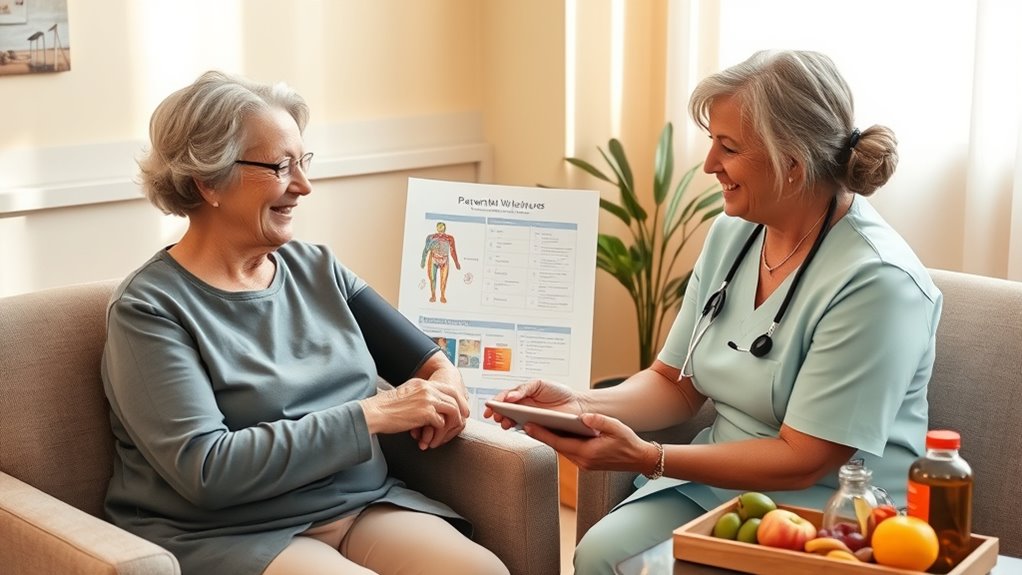
To personalize preventive care, you need to assess your functional capacity and understand how your daily activities are affected.
Evaluating your comorbidities and estimating your life expectancy helps determine which screenings and interventions are appropriate.
This tailored approach guarantees you receive care that aligns with your overall health and personal preferences.
Assessing Functional Capacity
Evaluating an elderly person’s functional capacity is essential for tailoring preventive care effectively. By appraising functional status and activities of daily living (ADLs), you gain insight into their independence and risk factors.
Use health assessments and prognostic models to estimate life expectancy, guiding appropriate interventions.
Consider these key points:
- Determine if they can manage basic ADLs like bathing, dressing, and eating.
- Evaluate instrumental activities such as shopping, managing medications, and transportation.
- Adjust preventive care strategies based on their functional status, prioritizing fall prevention for frail seniors or avoiding unnecessary screening for those with limited life expectancy.
This approach helps optimize preventive measures, balancing benefits and risks based on their health status and functional capacity.
Evaluating Comorbidities
Evaluating comorbidities is crucial for personalizing preventive care in older adults, as chronic conditions like diabetes, heart failure, or cancer can markedly shorten life expectancy and influence screening benefits. You should assess functional status using tools like ADLs and IADLs to determine how well you can manage daily tasks, which guides preventive decisions. Multiple severe chronic conditions may increase risks of complications, requiring careful consideration before recommending screenings or therapies. For example, screenings like mammograms or colonoscopies may offer limited benefit beyond five years of life expectancy, especially if you’re frail or severely ill. Understanding your comorbidities helps tailor interventions that maximize benefit and minimize harm.
| Condition | Impact on Life Expectancy |
|---|---|
| Diabetes | Reduces overall longevity |
| Heart failure | Limits functional capacity |
| Cancer | Affects screening benefits |
| Multiple conditions | Increase complication risk |
| Severity level | Guides preventive decisions |
Estimating Life Expectancy
Understanding your overall health status and existing conditions helps estimate how many years you might have remaining. To do this, consider factors like your functional status, comorbidities, and quality of life.
For example:
- Your ability to perform activities of daily living (ADLs) and instrumental activities (IADLs)
- The presence of chronic conditions affecting your health
- Results from tools like the geriatric prognostic index or clinical judgment
These assessments help determine your life expectancy and guide personalized care.
If your prognosis suggests limited years, some preventive interventions may offer little benefit.
Accurately estimating survival time enables you and your healthcare team to tailor preventive strategies, focusing on quality of life and appropriate screenings for your specific geriatric prognosis.
The Role of Behavioral Counseling in Prevention

Behavioral counseling plays a crucial role in preventing health issues among older adults by promoting positive lifestyle changes. Short, around 3-minute sessions can effectively support smoking cessation, especially when combined with pharmacologic aids like nicotine replacement therapy.
Counseling on healthy eating, physical activity, and moderation in alcohol intake has been linked to about a 50% reduction in mortality among seniors. These interventions also improve chronic disease management, leading to better overall health outcomes.
When tailored to your individual health status and risks, behavioral counseling encourages sustainable behavior changes and helps prevent complications. By addressing habits and promoting healthier choices, you can markedly reduce your risk of preventable health problems and maintain better quality of life as you age.
Evaluating Functional Ability and Life Expectancy

Evaluating your ability to perform daily activities provides valuable insight into your overall independence and health status. Your functional status, including assessments of activities of daily living (ADLs) and instrumental activities (IADLs), helps determine how well you manage daily tasks.
Consider these key factors:
- The presence of multiple comorbidities that may reduce your life expectancy.
- The use of prognostication tools to estimate your remaining years.
- The importance of screening appropriateness based on your functional ability and health outlook.
If your functional ability is limited or your comorbidities are extensive, your life expectancy may be less than five years. This information guides personalized preventive care, ensuring that interventions are beneficial and appropriate for your health status.
Incorporating Evidence-Based Preventive Therapies

You should consider tailoring screening guidelines to each elderly individual’s health status and preferences.
Promoting vaccination compliance, like flu and shingles shots, can greatly reduce illness and complications.
Additionally, emphasizing lifestyle changes such as quitting smoking and improving diet can enhance overall health and longevity.
Tailoring Screening Guidelines
Tailoring screening guidelines for the elderly requires a personalized approach that considers each patient’s overall health, life expectancy, and existing comorbidities. You should evaluate whether the benefits of screening outweigh potential harms, especially for those with limited life expectancy.
Key considerations include:
- Judging whether routine screening, like mammography or colon cancer tests, aligns with the patient’s health status.
- Recognizing that preventive strategies may need adjustment based on functional ability and prognosis.
- Deciding when to stop or modify screening based on evidence and individual health goals, ensuring personalized care.
This approach helps optimize screening practices for the elderly, balancing early detection with avoiding unnecessary interventions, all while incorporating evidence-based preventive therapies.
Promoting Vaccination Compliance
Why is promoting vaccination compliance essential for the elderly? Vaccinations are key to preventive care, reducing illness, complications, and hospitalizations. Ensuring elderly patients receive vaccines like influenza, pneumococcal, and shingles protects them from severe diseases. Healthcare providers should actively assess vaccination status during visits and encourage timely vaccine administration to improve compliance. Most insurance plans, including Medicare, cover these vaccines, making access easier. To visualize, consider the following ideas:
| Idea | Action | Benefit |
|---|---|---|
| Assess vaccination status | Review during each visit | Identify gaps in preventive care |
| Educate on vaccine importance | Explain benefits of vaccines | Increase compliance |
| Facilitate access | Offer vaccines on-site | Improve uptake |
| Remind patients | Use calls or messages | Boost adherence |
| Track vaccination rates | Maintain records | Ensure coverage of preventive therapies |
Emphasizing Lifestyle Changes
Building on the importance of vaccination compliance, incorporating lifestyle changes offers a powerful way to enhance health outcomes in older adults. You can achieve this through key lifestyle modifications, such as:
- Adopting a healthy diet rich in fruits, vegetables, and whole grains while eliminating trans fats.
- Engaging in regular physical activity, including strength training and aerobic exercises, to boost mobility, cognition, and mental health.
- Prioritizing smoking cessation, supported by behavioral counseling or medications, which can add years to your life expectancy.
These lifestyle modifications markedly reduce risks of coronary heart disease, stroke, frailty, and functional decline.
Combining healthy habits with vaccination adherence creates a holistic approach to aging gracefully and staying healthier longer.
Resources and Strategies to Stay Proactive in Health
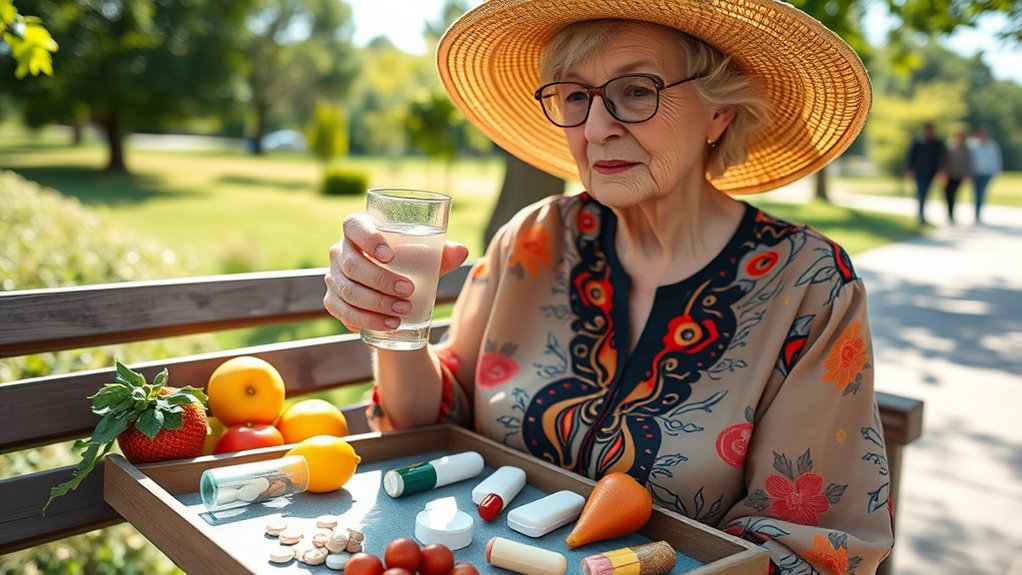
Staying proactive in health as you age involves utilizing a variety of trusted resources and strategies. For older adults, accessing reliable sources like the US Preventive Services Task Force guidelines helps you understand essential preventive care, including screenings and vaccinations.
The CDC offers aging-specific health resources to support your healthy aging journey, guaranteeing you stay informed about recommended tests and lifestyle tips. Educational tools like JAMA’s Patient Pages provide evidence-based advice in clear language, empowering you to make informed decisions.
Healthcare professionals rely on official sources such as the National Institute on Aging for current preventive health information. Incorporating these resources into your routine ensures you remain proactive, understand your screening needs, and maintain ideal health as you age.
Frequently Asked Questions
Which of the Following Preventive Care Measures Are Recommended for Elderly Patients?
You’re asking which preventive care measures are recommended for elderly patients. Regular annual wellness exams help detect issues early, so make sure to get screened for blood pressure, cholesterol, and diabetes.
Stay updated on vaccines like flu, pneumonia, and shingles. Women should consider mammograms and osteoporosis screening, while everyone benefits from lifestyle counseling to manage blood pressure and obesity.
These steps help maintain your health and prevent future complications.
What Are Examples of Primary Prevention for Elderly People?
Did you know that proper primary prevention can markedly extend an elderly person’s life? You should focus on vaccinations like flu, pneumonia, and shingles, which protect against infectious diseases.
Encourage a healthy diet and regular exercise to lower chronic illness risks. Promoting smoking cessation can add years to their life, while fall prevention strategies and regular screenings help maintain independence and reduce injury risks.
These proactive steps truly make a difference.
What Are 3 Examples of Preventive Health Care?
You’re asking for three examples of preventive health care. You can get annual flu shots, pneumococcal, and shingles vaccines to protect against common illnesses.
Additionally, scheduling regular screenings like mammograms and colorectal tests helps catch potential problems early.
Finally, blood tests for cholesterol and diabetes are essential to identify risks for heart disease and stroke.
These measures keep you healthier and more active as you age.
How to Improve Healthcare for the Elderly?
To truly transform elderly care, focus on fostering personalized, proactive practices. You can improve healthcare by promoting personalized plans that prioritize their unique needs, preferences, and capabilities.
Regularly recommend routine screenings and vaccinations to prevent illnesses.
Encourage healthy habits like proper nutrition and physical activity.
Conclusion
By staying proactive with regular check-ups, vaccinations, and screenings, you can age gracefully and maintain your independence. Embrace healthy lifestyle changes and seek behavioral support when needed—think of it as your modern-day Hippocratic oath. Remember, your health is your greatest treasure, so don’t wait for a “knock on the door.” Take charge today, and guarantee your golden years are filled with vitality and joy, just like the stories of old that inspire us.



